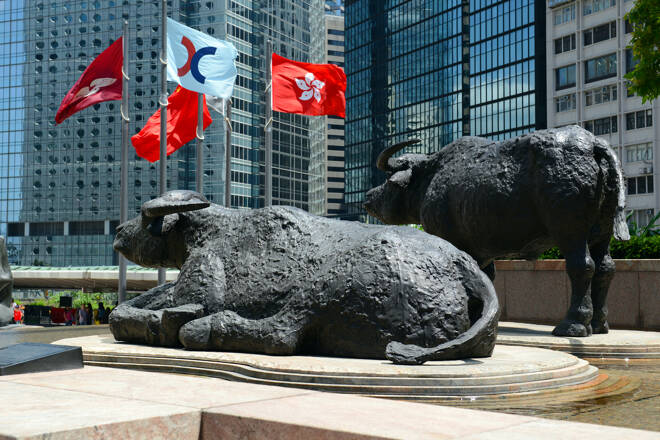Advertisement
Advertisement
Hang Seng Index, ASX200, Nikkei 225: US CPI Angst To Test Investors
By:
It is a quiet day ahead for the Hang Seng Index and broader markets. However, uncertainty toward the US CPI Report could test buyer appetite today.
Key Insights:
- It is likely to be a choppy Wednesday session for the Hang Seng Index and the broader Asian equity markets.
- This morning, we expect the Asian markets to react further to Fed commentary from Monday and the latest bets on Fed July and September interest rate hikes.
- However, investors may take a more cautious approach to the session with the US CPI Report out later in the day.
Market Overview
There were no US economic indicators from Monday to influence the Hang Seng Index and the broader Asian markets on Tuesday. The lack of US economic indicators left FOMC member speeches from Monday to resonate mid-week.
FOMC members Barr, Bostic, and Daly swayed sentiment in favor of riskier assets on Monday, raising the hopes of the Fed ending its monetary policy tightening cycle.
According to the CME FedWatch Tool, the probability of a 25-basis point July Fed rate hike was 92.4% versus 93.0% on Monday. Significantly, the chances of the Fed lifting rates to 5.75% in September stood at 24.0%, up from 22.3% on Monday.
The NASDAQ Composite Index found further support on Tuesday, gaining 0.55%, with the Dow and the S&P 500 rising by 0.93% and 0.67%, respectively.
From the Asian region, it was a relatively quiet Tuesday session However, hopes of further stimulus from Beijing, in response to China’s inflation numbers from Monday, drove demand for riskier assets.
Beijing extended real estate-related policies until 2024 to support the sector. The latest policy moves raised hopes of more significant stimulus to support the broader economy.
However, it could be a testier midweek session for the Asian markets, with the US CPI Report in focus later today. Sticky inflation would refuel bets on a hawkish post-summer Fed rate hike, a bearish outcome for riskier assets. Economists forecast the US annual inflation rate to soften from 4.0% to 3.1%.
There were no US economic indicators from Tuesday for investors to consider this morning.
ASX 200
On Monday, the ASX 200 gained 1.50%, with the China stimulus hopes and Australian economic indicators providing support. Business confidence and consumer confidence improved according to the latest NAB and Westpac surveys.
The NAB Business Confidence Index increased from -4 to 0 in June, while the Westpac Consumer Confidence Index increased by 2.7% to 81.3. Easing inflationary jitters supported a jump in consumer confidence, while consumers remained cautious about interest rates.
The big-4 had a bullish Tuesday. ANZ Group (ANZ) and The National Australia Bank (NAB) saw gains of 2.32% and 2.11%, respectively. The Commonwealth Bank of Australia (CBA) and Westpac Banking Corp (WBC) ended the day up 1.12% and 1.58%, respectively.
Mining stocks found much-needed support. Rio Tinto (RIO) and BHP Group Ltd (BHP) ended the day with gains of 1.29% and 1.43%, respectively, with Fortescue Metals Group (FMG) gaining by 1.98%. Newcrest Mining (NCM) rose by 1.77%. Beijing stimulus hopes drove demand for mining stocks.
Oil stocks had a bullish session. Woodside Energy Group (WDS) and Santos Ltd (STO) saw gains of 1.06% and 0.81%, respectively.
Hang Seng Index
The Hang Seng enjoyed a second day in positive territory, rising by 0.97%.
Considering the main Index components, Tencent Holdings Ltd (HK:0700) and Alibaba Group Holding Ltd (HK:9988) gained 1.52% and 2.01%, respectively. Bets on an end to the Beijing clampdown and stimulus hopes delivered a bullish session.
However, bank stocks had a mixed session. HSBC Holdings PLC and China Construction Bank (HK: 0939) fell by 0.33% and 0.46%, respectively. However, The Industrial and Commercial Bank of China (HK:1398) bucked the trend, gaining 0.28%.
CNOOC (HK: 0883) ended the day up 1.38%.
Nikkei 225
The Nikkei 225 ended Tuesday with a 0.04% gain, with a weaker USD/JPY and intervention threats overshadowing Beijing stimulus bets.
The banks had a bearish session. Sumitomo Mitsui Financial Group (8316) and Mitsubishi UFJ Financial Group ended the day with losses of 0.77% and 0.57%, respectively.
Looking at the main components, Tokyo Electron Limited (8035) bucked the trend, gaining 1.08%.
However, Sony Corp (6758) and KDDI Corp (9433) saw losses of 1.21% and 1.51%, respectively. SoftBank Group Corp. (9984) and Fast Retailing Co (9983) ended the day down 0.24% and 0.06%, respectively.
Check out our economic calendar for economic events.
About the Author
Bob Masonauthor
With over 28 years of experience in the financial industry, Bob has worked with various global rating agencies and multinational banks. Currently he is covering currencies, commodities, alternative asset classes and global equities, focusing mostly on European and Asian markets.
Did you find this article useful?
Latest news and analysis
Advertisement
